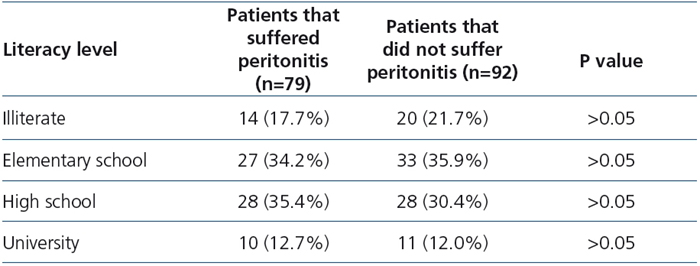My SciELO
Services on Demand
Journal
Article
Indicators
-
 Cited by SciELO
Cited by SciELO -
 Access statistics
Access statistics
Related links
-
 Cited by Google
Cited by Google -
 Similars in
SciELO
Similars in
SciELO -
 Similars in Google
Similars in Google
Share
Nefrología (Madrid)
On-line version ISSN 1989-2284Print version ISSN 0211-6995
Nefrología (Madr.) vol.34 n.3 Cantabria 2014
https://dx.doi.org/10.3265/Nefrologia.pre2014.Feb.12433
LETTERS TO THE EDITOR
Comment on ''Peritoneal dialysis-related peritonitis: twenty-seven years of experience in a Colombian medical center''
Dear Editor,
We read with great interest the article by Nieto-Rios et al. that was recently published in Nefrologia.1 In this study, the authors described the rates of continuous ambulatory peritoneal dialysis (CAPD) related peritonitis in a cohort of patients followed for 27 years in their center. They observed a steady rate of peritonitis throughout the three decades reviewed, despite the improvements of peritoneal dialysis techniques. Authors speculated that after the change in the social security system in the early 1990s in their country, more patients with low socioeconomic levels and illiteracy had access to CAPD which influence the rate of peritonitis.
We wanted to contribute our data about the effect of education level on peritonitis risk in peritoneal dialysis patients. We conducted a single center study to investigate the risk factors for development of peritonitis in 171 peritoneal dialysis patients within two years period. Seventy-nine patients (46.2%) had suffered peritonitis during follow-up period. One-hundred three peritonitis episodes were observed in these 79 patients. Sixty-one patients had one, 12 patients had two and 6 patients had three peritonitis episodes during the follow up period. Peritonitis rate was 1 in 31.4 patient months. Demographic characteristics of the patients including age, gender and previous hemodialysis history were not different between patients with and without peritonitis. Hemoglobin levels had also no effect on peritonitis risk. However diabetes was more prevalent in patients that suffered peritonitis compared to patients that did not suffered peritonitis (32.9% vs. 16.3%, respectively, p=0.01) and mean serum albumin level was lower in patients with peritonitis (3.1±4.8 vs. 3.2±4.1g/dL, p=0.04). Duration of peritoneal dialysis was longer in patients that suffered peritonitis (20.6±12.3 months vs. 17.5±10.1 months, p=0.01). Literacy levels were similar between two groups (Table 1).
Table 1. Literacy Levels in Patients that Suffered and did not Suffer Peritonitis 
Although low education level had been shown as a risk factor for peritonitis in some previous studies,2,4 we did not observe an effect of literacy level on peritonitis risk. This discrepancy may be explained by the fact that support from well-educated familial members of patients with low educational status may help to decrease the peritonitis risk. We believe that low education level should not be a contraindication for peritoneal dialysis provided that well educated family members assist in performing the dialysis procedure.
Conflict of interest
The authors declare that they have no conflicts of interest related to the contents of this article.
Tolga Yildirim1, Dicle Koca-Iskender2,
Zafer Ercan1, Deniz Ayli1
1 Department of Nephrology.
Ankara Diskapi Yildirim Beyazit Training and Research Hospital.
Ankara (Turkey)
2 Department of Internal Medicine.
Ankara Diskapi Yildirim Beyazit Training and Research Hospital.
Ankara (Turkey)
References
1. Nieto-Ríos JF, Díaz-Betancur JS, Arbeláez-Gómez M, García-García A, Rodelo-Ceballos J, Reino-Buelvas A, et al. Peritoneal dialysis-related peritonitis: twenty-seven years of experience in a Colombian medical center. Nefrologia 2014;34(1):88-95. [ Links ]
2. Martin L, Caramori J, Fernandes F, Divino-Filho JC, Pecoits-Filho R, Barretti P. Geographic and educational factors and risk of the first peritonitis episode in Brazilian Peritoneal Dialysis study (BRAZPD) patients. Clin J Am Soc Nephrol 2011;6:1944-51. [ Links ]
3. Farias MG, Soucie JM, McClellan W, Mitch WE. Race and the risk of peritonitis: an analysis of factors associated with the initial episode. Kidney Int 1994;46(5):1392-6. [ Links ]
4. Chern YB, Ho PS, Kuo LC, Chen JB. Lower education level is a major risk factor for peritonitis incidence in chronic peritoneal dialysis patients: a retrospective cohort study with 12-year follow-up. Perit Dial Int 2013;33(5):552-8. [ Links ]
![]() Correspondence:
Correspondence:
Tolga Yildirim,
Department of Nephrology,
Ankara Diskapi Yildirim Beyazit Training and Research Hospital,
Irfan Bastug Caddesi Diskapi Ankara,
06100, Ankara, Turkey
E-mail: tolga.yildirim@hacettepe.edu.tr














